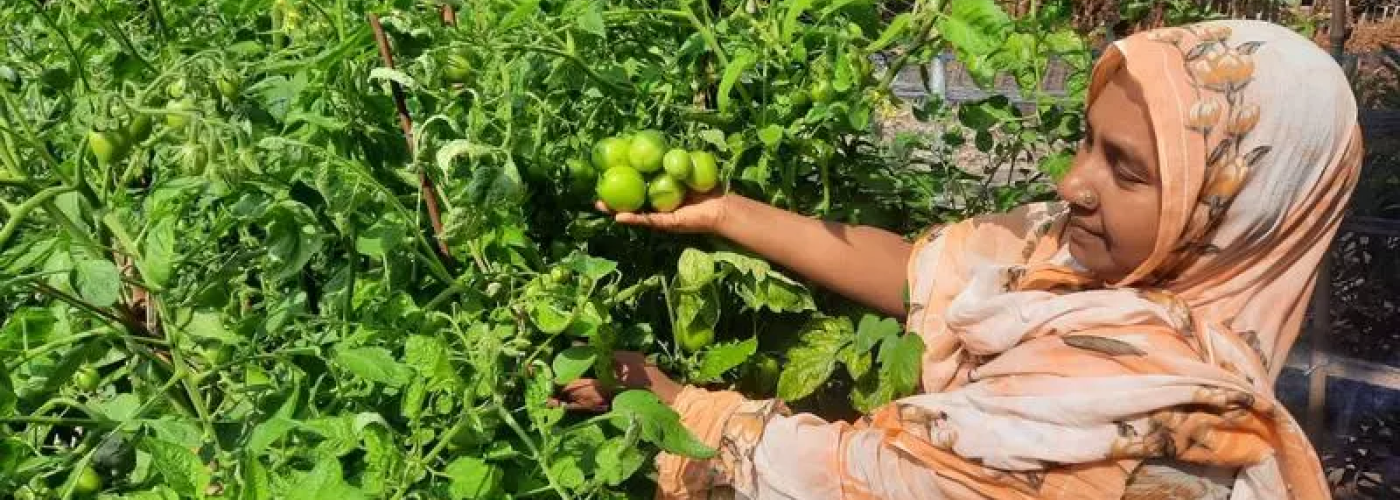Sowing Commercial Interest in Homestead Gardening
Image

This post is authored by Ramakrishnan Ganesan and Md. Ashraful Islam of the Feed the Future Bangladesh Nutrition Activity and is part of the Marketlinks and Agrilinks co-hosted month of October exploring the role that private sector engagement can play in advancing nutrition outcomes. It is also published on Agrilinks.
As leaders of the Feed the Future Bangladesh Nutrition Activity, we have a large, multifaceted mandate that includes increasing consumption of diverse foods; empowering women and adolescents; increasing adoption of improved water, sanitation and hygiene behaviors; and promoting environment-friendly solutions. Engaging the private sector has been integral to our success, fueled by shared benefit principles. And for one of our main initiatives, it’s doing so literally where people live.
Since 2020, our Activity has teamed with agri-input suppliers and retailers to establish nearly 800 “demonstration” homestead gardens in three regions of Bangladesh with historically high malnutrition and poverty levels. These gardens, averaging 40 square meters in size, may seem humble, but they are a nexus for several Feed the Future goals: good nutrition, women’s empowerment and environmentally safer horticulture. These demonstration gardens have motivated nearly 45,000 households to start their own homestead gardens, benefiting nearly 200,000 rural Bangladeshis. Throughout, the private sector has been a dynamic partner, adding energy, ideas and credibility to our efforts — and of course, a regular supply of seeds, new technologies and other inputs.
Sharing risk for market entry
We offer financial risk mitigation through grants to interest agribusiness firms to start working in rural areas and target homestead cultivators, or to introduce a new agri-technology. These typically cover 12 months of working with us, ranging from $20,000 to $35,000, and come with certain conditions, such as educating communities on nutrition, demonstrating good agricultural practices and providing follow-up advisory to new homestead gardeners. At the end of the grant period, these firms decide if they see enough returns to justify continued investment.
We’ve found that some see value in these new markets and customer bases, continuing or expanding their initial work after the grant period ends. One of our partnering agri-input companies reported a 75% increase in sales during the partnership, yielding an additional $120,000 from just one of Bangladesh’s 64 districts.
Boosting Activity results
Buoyed by the private sector, we’ve made measurable strides toward solving these overlapping problem areas on a scale that would have been impossible otherwise.
A principal cause of malnutrition in Bangladesh is a lack of diverse foods consumed, specifically green leafy and yellow, Vitamin A-rich vegetables. Many Bangladeshi women are homebound for cultural reasons and lack their own income, inhibiting their ability to purchase these foods from the market. Those households with homestead gardens limit the number of crops they cultivate and their growing season.
By promoting good agricultural practices, use of appropriate agri-inputs and educating communities on the importance of diverse, nutritious diets, our private sector partners have helped increase household access to these essential foods and improve the nutritional outcomes of women and children. Our surveys show the Activity has contributed to a 10-percentage-point increase in the proportion of women in project areas consuming diverse, nutritious diets, from 81% in 2019 to 91% in 2021.
As women manage most homestead gardens, they can earn income by selling surplus, enhancing their status within their families and society. During a field visit to Faridpur, we met Feroza Begum, the only earning member of a family of five, who explained she has more than doubled her income, calling it a “great support to run my family.” On average, women feed their families from these homestead gardens and have enough left over to sell 30-50% of their harvests.
After Activity training, agri-input dealers are also promoting a grassroots uptake of environmentally safer horticulture, including organic fertilizer and biopesticide solutions, such as pheromone traps, yellow sticky cards, vermicompost and Trichoderma. Our reports show that training for agri-input retailers and grassroots promotion has increased sales of these products by 9% annually.
Learning from private sector engagement
Commercial partners for homestead gardens have taught us keys to success for similar efforts in agriculture.
- Find the right-sized partner: Large commercial farmers purchase most agri-inputs, and large agri-input companies focus on them. Mid-sized companies willing to invest in expanding their sales may be more appropriate partners for smaller market segments, like homestead gardeners. We’ve also targeted partners with the right pack sizes — mini and combo packs — and those with a wider range of products.
- Identify appropriate solutions: It is critical to partner with a company that has appropriate solutions for the target geography. In areas where the soil is salinized due to repeated coastal flooding, the Activity partnered with companies that promote technologies, like seedling trays and coco-peat, a soil substitute.
- Address root constraints to demand: Initial Activity assessments identified a key barrier to homestead gardening, a lack of knowledge of nutrition and the importance of diversified diets. We then supported our partners in developing and implementing social behavior change activities to address this barrier up front and stimulate demand.
Looking forward: What’s next?
We see opportunities to strengthen and expand commercial interest on both the input and output sides of this market. We are exploring partnerships with new market actors who can bring in new varieties of seeds and other inputs to enable households to cultivate foods year-round in four to five harvest cycles. We are also in discussion with food processing companies and food vendors to tap homestead cultivators as suppliers — and even processors themselves. With this, we expect to increase income and empowerment of homestead cultivators while reducing food loss and wastage.

